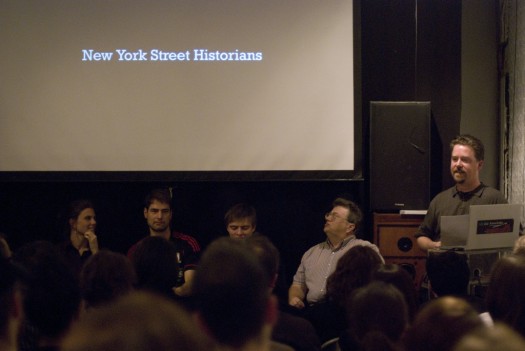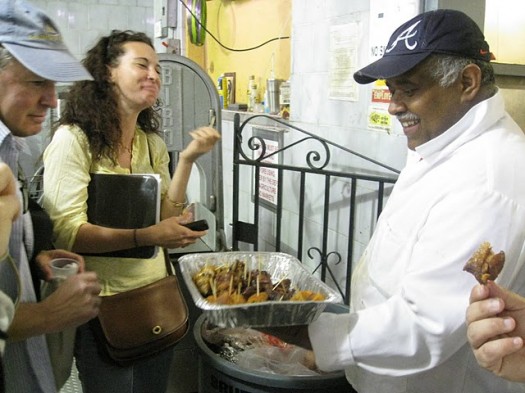
We are celebrating 15 years — and counting — of stories that are deeply researched and deeply felt, that build a historical record of what the city has been.
We are celebrating 15 years — and counting — of stories that are deeply researched and deeply felt, that build a historical record of what the city has been.

Photo by Aubrey Gallegos, via UnionDocs
On November 20, Nathan Kensinger, in collaboration with UnionDocs, presented “Block by Block,” a panel discussion with four of New York’s most active street historians. Author Kevin Walsh, location scout Nick Carr, urban explorer Moses Gates and guide Cindy VandenBosch exemplify a vital and contemporary iteration of the long-standing New York tradition of “un-official,” “informal,” “underground,” and “alternative” histories. The event presented each individual’s work, methodology, adventures and stories, and in so doing managed to challenge many of our assumptions about how history is traditionally written, and how subverting those traditions can open up new avenues of urban exploration.
Kensinger, no slouch in the business of New York underground documentation himself, began the panel by framing the practice of street history in New York. Kensinger described the explorations of George G. Foster, a pioneer of nonfiction urban sensationalism. In the 1800s, Foster was working to document the whole of the rapidly changing city, through books such as New York by Gas Light and Other Urban Sketches and New York in Slices. His writing laid the groundwork for many writers of the early 20th century known for their exploration of New York’s underbelly, including Joseph Mitchell (McSorley’s Wonderful Saloon) and St. Clair McKelway (True Tales from the Annals of Crime and Rascality), both also known for their contributions to the early years of The New Yorker. Like Foster before them, these writers opened doors for other 20th century talents like columnist Meyer Berger and audio documentarian Tony Schwartz. Just as each of the previous generations of New York historians felt a duty to expand public understanding of the breadth and diversity of urban experience in New York, the panelists Kensinger invited to this event exhibited a sense of wonder, responsibility and anxiety about representing the city they call home.
The first presenter of the evening was Kevin Walsh of Forgotten New York. Walsh, by his own account, is now an author, but has always identified himself foremost as an urban explorer. A New York native, he came of age investigating the streets, fascinated by the stories they tell. And in 1997, when the Internet, as he said, “started getting popular,” he saw an opportunity and a platform upon which he could finally share his explorations. By 1998, he was out every weekend, photographing all along the way. During his many journeys, he has found the few remaining red-brick paved roads and some rare two-light stoplights that flash only red and green, explored New York neighborhood institutions like Red Hook’s Sunny’s Bar and Narrows Coffee Shop, and exposed the bucolic beauty of Park Slope’s Webster and Jackson Places with equal excitement as the gruesome history of Atlantic Terminal’s prior life as a meatpacking plant.

5 Beekman Street | Photo by Nick Carr/Scouting New York
Nick Carr is a location scout for the movie industry is the author of Scouting New York. After graduating from college, he wanted to work in film production. Following a couple twists and turns that involved figuring out where to locate trailers on the set and how to run telephone lines to them, he managed to find regular work in the locations department and worked his way up to being a scout. Working on films like Spiderman 3 and The Taking of Pelham 123, one would expect that Carr’s work has taken him to some of New York’s most inaccessible rooftops and abandoned buildings, but it has also found him in the last arcade in Chinatown and rooftop beach houses. He has tracked down rats in Grand Central Station and owls in Hearld Square. His words of advice on scouting the next spot? Keep your eyes open, New York is always changing.
Moses Gates of All City New York presented next. An urban explorer, planner and demographer, Gates has taken on a number of ambitious urban adventures goals. First, he decided to climb every bridge in New York, then to explore all of New York’s abandoned subway stations and most recently to walk all of New York’s census tracts. Gates began by showing some stomach-jolting photos of his bridge climbs and curiosity-sparking images of his subway explorations. Then, he dove into his census tract exploration. As of November 20th, Gates had walked 83.5% of New York’s census tracts as outlined by the census conducted in the year 2000. Over the course of his walks, he began to wonder about the totality of New York in contrast to image of New York. Does Chelsea or Ridgewood offer a more “real” New York? Jackson Heights or Bayside? Using census microdata, the demographer in him decided to figure out which neighborhood’s statistics most closely match the citywide averages for income, racial composition and other census categories. The winner? Pelham Parkway in the Bronx.
Cindy VandenBosch of Urban Oyster was the final presenter. Drawing on her background in anthropology, she wanted to create a tour company that would not just simply showcase a space, but allow the participant to experience it as a place. With topics ranging from food carts to churches to the Brooklyn Navy Yard, her tours expand the traditional visual tour experience by drawing in locals for discussion, tastings and oral histories. She took us through the makings of her Immigrant Foodways tour. In 2008, when a signature campaign stopped its repurposing, the Moore Street Market drew VandenBosch’s attention. The Market, she explained, was originally formed under the LaGuardia administration in an effort “to turn the peddlers of yesterday into the merchants of tomorrow,” by centralizing them indoors. With the market as a starting place, VandenBosch’s investigations expanded into the neighborhood. She found a wealth of food-centric stories from the butcher shops that once lined Moore Street to the steer drive that took place on Johnson Avenue. Through her connection to the neighborhood and communities with whom she works, her tours are filled with resident’s personal histories in equal amount as urban history, offering a well-rounded rendering of the places rather than simply the spaces through which she leads tours.

Co-owner of Anibal Meat Market, Angelo Santiago, offers up some pernil and roasted chicken to attendees of one of VandenBosch’s tours | Photo by Andrew Gustafson, courtesy of Cindy VandenBosch
Following the presentations, Kensinger opened a question and answer session with audience. It took no time at all for the issue of change in the city to take over the discussion. Walsh lamented the loss of architectural individualism and the resulting aesthetic homogenization of the built environment. Carr took on the frequency of construction, adaptation, renovation and demolition. Gates discussed the city’s demographic changes — the city is more expensive than ever before, but remains socially diverse. VanderBosch queried the way in which the landmarking process occurs: should it be with reference to the narrative of the place or the structure?
Walsh summed up the crux of his argument with an anecdote. He was out walking and photographing when met a friend, to whom he complained that a beautiful old baroque building had been torn down and replaced with standardized box apartments (what he calls “Fedders,” in reference to the air conditioners that adorns their windows). His friend told him to stop complaining; this is what people can afford; this is what makes sense for the neighborhood as it is now. Her scolding was based in economics, demographics and practicality, while his sensibility lay in aesthetics and nostalgia. Hence Walsh’s question: where is the line? What amount of historic or aesthetic value is sufficient to justify deterring or slowing physical change, even when rapid change makes the most economic sense?
Not all development dilemmas are this clear-cut, and the discussion brought to mind the complex challenges of shaping the city’s future in a way that respects its past. Both economic development and historic preservation play important roles and, while it is impossible to single-handedly predict or determine the future, we can be sure that this group of street historians and urban explorers will remind us of the best of the past. In just a few hours, they led us through some of New York’s “secret” spaces, shifted the mythologies we believe about the city, and opened our eyes to the complex historical narratives that we pass by everyday. And, at the end of our exploration, they raise key questions about which of New York’s spaces, places and mythologies will continue to be preserved. What vestiges of this New York will we find in the next version of New York? It will be up to the next generation of street historians to explore, document and share.
The views expressed here are those of the author only and do not reflect the position of Urban Omnibus editorial staff or the Architectural League of New York.
The views expressed here are those of the authors only and do not reflect the position of The Architectural League of New York.
Comments